Shading Calculation Methods and Regulation Simplifications—The Portuguese Case
Abstract
1. Introduction
1.1. Selecting Shadow Case Studies
1.2. Selecting Shadow Calculation Methods
1.3. Legislative Requirements
2. Methodology
2.1. Portuguese Calculation Methodology
2.1.1. Horizon Shading Factor
2.1.2. Shading Factor for Horizontal or Vertical Obstruction
3. Results and Portuguese Case
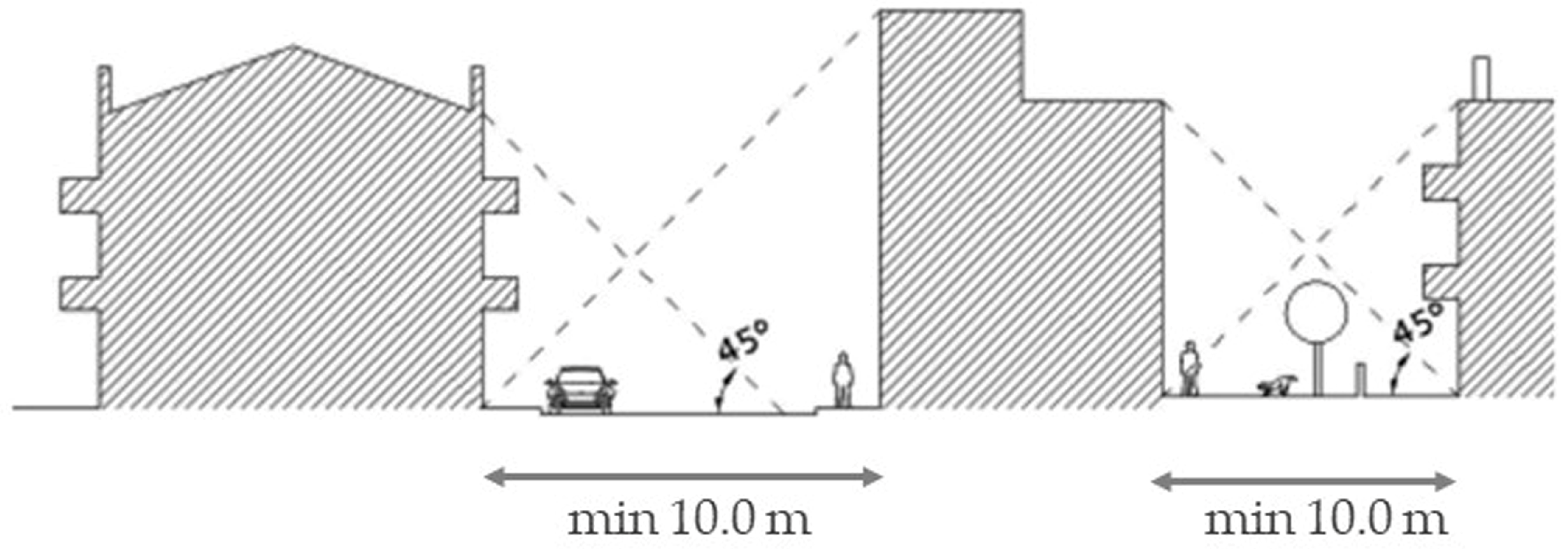
3.1. Discussion of the Gaps of Thermal Regulation in Portugal, Compromising the Angles of Obstruction
3.2. Discussion of the Gaps in Thermal Regulation in Portugal, Compromising Calculation Periods
4. Conclusions
Author Contributions
Funding
Data Availability Statement
Acknowledgments
Conflicts of Interest
References
- Development Goals|United Nations Development Programme. Available online: https://www.undp.org/sustainable-development-goals (accessed on 3 April 2023).
- Aelenei, L. NZEB, Passive Solutions and Integration in Façades. 2022. Available online: https://www.lneg.pt/wp-content/uploads/2022/05/laura-aelenei-4-maio-2022.pdf (accessed on 4 May 2022).
- Silva, S.M.; Mateus, R.; Marques, L.; Ramos, M.; Almeida, M. Contribution of the Solar Systems to the NZEB and ZEB Design Concept in Portugal—Energy, Economics and Environmental Life Cycle Analysis. Sol. Energy Mater. Sol. Cells 2016, 156, 59–74. [Google Scholar] [CrossRef]
- Crowe, S.; Cresswell, K.; Robertson, A.; Huby, G.; Avery, A.; Sheikh, A. The Case Study Approach. BMC Med. Res. Methodol. 2011, 11, 100. [Google Scholar] [CrossRef]
- Reinhart, C.F.; Cerezo Davila, C. Urban Building Energy Modeling—A Review of a Nascent Field. Build. Environ. 2016, 97, 196–202. [Google Scholar] [CrossRef]
- Swan, L.G.; Ugursal, V.I. Modeling of End-Use Energy Consumption in the Residential Sector: A Review of Modeling Techniques. Renew. Sustain. Energy Rev. 2009, 13, 1819–1835. [Google Scholar] [CrossRef]
- Li, W.; Zhou, Y.; Cetin, K.; Eom, J.; Wang, Y.; Chen, G.; Zhang, X. Modeling Urban Building Energy Use: A Review of Modeling Approaches and Procedures. Energy 2017, 141, 2445–2457. [Google Scholar] [CrossRef]
- Harish, V.S.K.V.; Kumar, A. A Review on Modeling and Simulation of Building Energy Systems. Renew. Sustain. Energy Rev. 2016, 56, 1272–1292. [Google Scholar] [CrossRef]
- Allegrini, J.; Orehounig, K.; Mavromatidis, G.; Ruesch, F.; Dorer, V.; Evins, R. A Review of Modelling Approaches and Tools for the Simulation of District-Scale Energy Systems. Renew. Sustain. Energy Rev. 2015, 52, 1391–1404. [Google Scholar] [CrossRef]
- Ryerson, C.C. Mapping Solar Access in High Relief Areas for Regional Energy Planning. Prof. Geogr. 1984, 36, 345–352. [Google Scholar] [CrossRef]
- Belakehal, A.; Tabet, A.K. Shading and shadowing: Concepts for an interactive strategy between solar control and aesthetics in the design of the facade. Reference to arid zones. Renew. Energy 1996, 8, 323–326. [Google Scholar] [CrossRef]
- Al-Sallal, K.A. Solar Access/Shading and Building Form: Geometrical Study of the Traditional Housing Cluster in Sana’a. Renew. Energy 1996, 8, 331–334. [Google Scholar] [CrossRef]
- Belakehal, A.; Tabet, A.K. Experimental Assessment of Shading and Shadowing Strategy, Case of Facade’s Cantilevered Volumes. Reference to Dwellings in Arid Lands. Int. J. Ambient Energy 2000, 21, 179–186. [Google Scholar] [CrossRef]
- Capeluto, I.G. Energy Performance of the Self-Shading Building Envelope. Energy Build. 2003, 35, 327–336. [Google Scholar] [CrossRef]
- Bourbia, F.; Awbi, H. Building Cluster and Shading in Urban Canyon for Hot Dry Climate: Part 2: Shading Simulations. Renew. Energy 2004, 29, 291–301. [Google Scholar] [CrossRef]
- Chua, K.J.; Chou, S.K. Evaluating the Performance of Shading Devices and Glazing Types to Promote Energy Efficiency of Residential Buildings. Build. Simul. 2010, 3, 181–194. [Google Scholar] [CrossRef]
- Hayman, S. Limits of Accuracy of Graphical Solar Access and Shadow Studies. Archit. Sci. Rev. 2011, 32, 15–20. [Google Scholar] [CrossRef]
- Grynning, S.; Time, B.; Matusiak, B. Solar Shading Control Strategies in Cold Climates—Heating, Cooling Demand and Daylight Availability in Office Spaces. Sol. Energy 2014, 107, 182–194. [Google Scholar] [CrossRef]
- Shukla, K.N.; Rangnekar, S.; Sudhakar, K. Comparative Study of Isotropic and Anisotropic Sky Models to Estimate Solar Radiation Incident on Tilted Surface: A Case Study for Bhopal, India. Energy Rep. 2015, 1, 96–103. [Google Scholar] [CrossRef]
- Aksamija, A. Design Methods for Sustainable, High-Performance Building Facades. Adv. Build. Energy Res. 2015, 10, 240–262. [Google Scholar] [CrossRef]
- De Simón-Martín, M.; Díez-Mediavilla, M.; Alonso-Tristán, C. Shadow-Band Radiometer Measurement of Diffuse Solar Irradiance: Calculation of Geometrical and Total Correction Factors. Sol. Energy 2016, 139, 85–99. [Google Scholar] [CrossRef]
- Lee, K.S.; Han, K.J.; Lee, J.W. The Impact of Shading Type and Azimuth Orientation on the Daylighting in a Classroom-Focusing on Effectiveness of Façade Shading, Comparing the Results of Da and Udi. Energies 2017, 10, 635. [Google Scholar] [CrossRef]
- Sari, D.P.; Laksana, P.J.B. Optimization Building Performance in Early Design Stage Using Integrated Dynam-Ic Model. Modul 2020, 20, 151–156. [Google Scholar] [CrossRef]
- Kimm, G. Actual and Experiential Shadow Origin Tagging: A 2.5D Algorithm for Efficient Precinct-Scale Modelling. Int. J. Archit. Comput. 2020, 18, 41–52. [Google Scholar] [CrossRef]
- Garreau, E.; Berthou, T.; Duplessis, B.; Partenay, V.; Marchio, D. Solar Shading and Multi-Zone Thermal Simulation: Parsimonious Modelling at Urban Scale. Energy Build. 2021, 249, 111176. [Google Scholar] [CrossRef]
- Dagher, S.; Akhozheya, B.; Slimani, H. Energy Analysis Studying the Effect of Solar Shading on Daylight Factors and Cooling Hours in an Extreme Weather. Energy Rep. 2022, 8, 443–448. [Google Scholar] [CrossRef]
- Wen, J.; Yang, S.; Xie, Y.; Yu, J.; Lin, B. A Fast Calculation Tool for Assessing the Shading Effect of Surrounding Buildings on Window Transmitted Solar Radiation Energy. Sustain. Cities Soc. 2022, 81, 103834. [Google Scholar] [CrossRef]
- Wen, J.; Xie, Y.; Yang, S.; Yu, J.; Lin, B. Study of Surrounding Buildings’ Shading Effect on Solar Radiation through Windows in Different Climates. Sustain. Cities Soc. 2022, 86, 104143. [Google Scholar] [CrossRef]
- Wang, X.; Zhang, X.; Zhu, S.; Ren, J.; Causone, F.; Ye, Y.; Jin, X.; Zhou, X.; Shi, X. A Novel and Efficient Method for Calculating Beam Shadows on Exterior Surfaces of Buildings in Dense Urban Contexts. Build. Environ. 2023, 229, 109937. [Google Scholar] [CrossRef]
- SalazarIi Trujillo, J.H. Solar Performance and Shadow Behaviour in Buildings. Case Study with Computer Modelling of a Building in Loranca, Spain. Build. Environ. 1998, 33, 117–130. [Google Scholar] [CrossRef]
- Carneiro, C.; Morello, E.; Desthieux, G.; Golay, F. Urban Environment Quality Indicators: Application to Solar Radiation and Morphological Analysis on Built Area. In Proceedings of the 3rd WSEAS International Conference on Visualization, Imaging and Simulation, Faro, Portugal, 3–5 November 2010; pp. 141–148. [Google Scholar]
- Grifoni, R.C.; Lapucci, D.; Petrucci, E.; Prenna, E. Method to Define a Solar Energy Platform for Historical City Centers and Identification of New Scenarios for Sustainability. In Proceedings of the IEEE 16th International Conference on Environment and Electrical Engineering (EEEIC), Florence, Italy, 7–10 June 2016. [Google Scholar]
- Kite, S. Shadow-Makers: A Cultural History of Shadows in Architecture; Bloomsbury Academic: London, UK, 2017. [Google Scholar]
- Valladares-Rendón, L.G.; Schmid, G.; Lo, S.L. Review on Energy Savings by Solar Control Techniques and Optimal Building Orientation for the Strategic Placement of Façade Shading Systems. In Energy and Buildings; Elsevier: Amsterdam, The Netherlands, 2017; pp. 458–479. [Google Scholar]
- Vartholomaios, A. A Parametric Sensitivity Analysis of the Influence of Urban Form on Domestic Energy Consumption for Heating and Cooling in a Mediterranean City. Sustain. Cities Soc. 2017, 28, 135–145. [Google Scholar] [CrossRef]
- Alagoz, M.; Beyhan, F. Methods to Discover the Optimum Building Envelope in the Context of Solar Data. Gazi Univ. J. Sci. 2020, 33, 318–340. [Google Scholar] [CrossRef]
- Kanters, J.; Gentile, N.; Bernardo, R. Planning for Solar Access in Sweden: Routines, Metrics, and Tools. Urban, Plan. Transp. Res. 2021, 9, 347–367. [Google Scholar] [CrossRef]
- Silva, A.P.D. Energy Efficiency of Buildings Located in the Municipality of Évora: A Case Study. Master’s Thesis, University of Évora, Évora, Portugal, 2009. Available online: http://hdl.handle.net/10174/13004 (accessed on 14 December 2022).
- Silva, J.J.C.; Henriques, P.M.C. Proposal for a New Methodology for Calculating the Shading Factor of Glazed Spans by Horizontal Elements. Construction Congress 2012, Ed.; University of Coimbra: Coimbra, Portugal, 2012; pp. 1–9. [Google Scholar]
- Lopes, A.B. Harmonised Methodology for Evaluating Thermal Behaviour and Energy Performance of Buildings: Study of Solar Gains; University of Coimbra: Coimbra, Portugal, 2016; Available online: http://hdl.handle.net/10316/38729 (accessed on 1 May 2023).
- Ferreira, S.F. Impact of the New Regulations on Energy Certification of Buildings, Superior Institute of Engineering, University of Algarve, Faro, Portugal. 2016. Available online: http://hdl.handle.net/10400.1/8448 (accessed on 3 April 2023).
- Costa, J.M.S. Evaluation of the Potential for Optimising the Thermo-Energetic Behaviour of Residential Buildings. Master’s Thesis, School of Engineering, University of Minho, Braga, Portugal, 2016. Available online: https://hdl.handle.net/1822/49816 (accessed on 4 June 2023).
- Da Carreira, R.F.C. Determination of Shading Factors Using 3D Models. Master’s Thesis, Energy and Environmental Engineering, Faculty of Sciences, University of Lisbon, Lisbon, Portugal, 2017. Available online: https://repositorio.ul.pt/handle/10451/32041 (accessed on 3 April 2023).
- Brito, M.C.; Redweik, P.; Catita, C.; Freitas, S.; Santos, M. 3D Solar Potential in the Urban Environment: A Case Study in Lisbon. Energies 2019, 12, 3457. [Google Scholar] [CrossRef]
- Silva, S.M. Sustainability and Comfort in Buildings. Ph.D. Thesis, Civil Engineering, University of Minho, Braga, Portugal, 2009. Available online: https://hdl.handle.net/1822/10245 (accessed on 5 April 2023).
- Fortunato, V.; Rato, V. Architectural Integration of Optimised Solar Shading. ISTAR-RN 2017, 15, 4–23. Available online: http://hdl.handle.net/10071/18144 (accessed on 5 April 2023).
- Cascone, Y.; Corrado, V.; Serra, V. Calculation Procedure of the Shading Factor under Complex Boundary Conditions. Sol. Energy 2011, 85, 2524–2539. [Google Scholar] [CrossRef]
- Decree-Law No 49/90 (RCCTE); Official Journal of the Republic No 31/1990, Series I of 6 February 1990: Portugal. 1990. Available online: https://dre.pt/dre/detalhe/diario-republica/31-1990-4394525 (accessed on 5 April 2023).
- Directive 2002/91/EC of the European Parliament and of the Council of 16 December 2002 (EPBD). 2002. Available online: https://eur-lex.europa.eu/legal-content/PT/TXT/?uri=celex%3A32002L0091 (accessed on 5 April 2023).
- Decree-Law No. 118/2013 (SCE, REH, RECS); Portugal. 2013, pp. 4988–5005. Available online: https://drehttps//dre.pt/application/conteudo/499237 (accessed on 5 April 2023).
- Letras, S.G.M. Nominal Energy Demand in Residential Buildings Comparison between the Methodologies of the RCCTE, REH and 5R1C Model. Master’s Thesis, University of Lisbon, Lisbon, Portugal, 2014. Available online: http://hdl.handle.net/10451/16107 (accessed on 5 April 2023).
- Sombrero. Available online: http://nesa1.uni-siegen.de/softlab/download/SOMBRERO_Manual.pdf (accessed on 5 April 2023).
- Shading Analysis. Available online: http://andrewmarsh.com/software/app-shading/ (accessed on 5 April 2023).
- ShadowFX—Sun and shadow analysis. Available online: http://www.shadowfx.com/ (accessed on 5 April 2023).
- TownScope. Available online: http://www.townscope.com/ (accessed on 5 April 2023).
- Sunhoursplugin. Available online: https://www.sunhoursplugin.com/ (accessed on 5 April 2023).
- Gosol. Available online: http://www.gosol.de/gosol-software.html (accessed on 5 April 2023).
- Analysis SOL-AR-Laboratório de Eficiência Energética em Edificações. Available online: https://labeee.ufsc.br/downloads/softwares/analysis-sol-ar (accessed on 5 April 2023).
- ArcGIS Spatial Analyst -Solar Analysis. Available online: https://www.esriuk.com/software/arcgis/extensions/spatialanalyst/key-features/solar (accessed on 5 April 2023).
- SunEye 210 Shade Tool. Available online: https://www.solmetric.com/buy210.html (accessed on 5 April 2023).
- Solar Pathfinder—Solar Site Analysis. Available online: https://www.solarpathfinder.com/ (accessed on 5 April 2023).
- Horicatcher -Meteonorm. Available online: https://meteonorm.com/en/product/horicatcher (accessed on 5 April 2023).
- Order (Extract) No. 15793-K/2013; Official Journal of the Republic No 234/2013, 3rd Supplement, Series II of 2013-12-03, Portugal. 2013, pp. 35088-(58)–35088-(87). Available online: https://dre.pt/dre/detalhe/despacho-extrato/15793-k-2013-2975224 (accessed on 5 April 2023).
- ENVI-Met. Available online: https://www.envi-met.com/pt-pt/estudantes/#analise-solar (accessed on 5 April 2023).
- Ladybug. Available online: https://www.ladybug.tools/ladybug.html (accessed on 5 April 2023).
- Order (Extract), No. 15793-E/2013; Official Journal of the Republic No 234/2013, 3rd Supplement, Series II de 2013-12-03, Portugal. Available online: https://dre.pt/dre/detalhe/despacho-extrato/15793-e-2013-2975218 (accessed on 5 April 2023).
- Cunha, M.M.F. Glazed Openings—Insolation Geometry—Optimisation of the Dimensioning of Solar Protection Elements; 2005. Available online: https://paginas.fe.up.pt/~vpfreita/mce04004_geometria_de_insolacao.pdf (accessed on 5 April 2023).
- Agency for Energy (ADENE). Available online: https://www.adene.pt/ (accessed on 14 May 2023).
- National Institute of Statistics (INE). Portugal 2021 Census. Available online: https://censos.ine.pt/xportal/xmain?xpgid=censos21_main&xpid=censos21&xlang=pt (accessed on 5 April 2023).
- Decree-Law, No. 38 382 (RGEU); The Journal of the Government n. 1951. Available online: https://dre.pt/dre/legislacao-consolidada/decreto-lei/1951-120610500-201155062 (accessed on 5 April 2023).
- Order (Extract) No. 15793-F/2013; Portugal. 2013, pp. 35088-(26)–35088-(31). Available online: https://dre.pt/dre/detalhe/despacho-extrato/15793-f-2013-2975219 (accessed on 5 April 2023).
- Coutinho, H.M.S. Relation between Urban Form and Solar Radiation on Buildings. Master’s Thesis, Civil and Environmental Engineering, Higher School of Technology and Management, Polytechnic Institute of Viana do Castelo, Viana do Castelo, Portugal, 2018. Available online: https://repositorio.ipvc.pt/handle/2 (accessed on 2 May 2023).
- Archicad—BIM. Available online: https://graphisoft.com/solutions/archicad#archicad (accessed on 15 May 2023).
- Grasshopper—Algorithmic Modeling for Rhino. Available online: https://www.grasshopper3d.com/ (accessed on 14 May 2023).
- Rhino 6 for Windows and Mac. Available online: https://www.rhino3d.com/ (accessed on 14 June 2020).
- Ouria, M. Solar Energy Potential According to Climatic and Geometrical Parameters of Cities and Buildings: A Case-Study from Tabriz City- Iran. Urban Clim. 2019, 28, 100469. [Google Scholar] [CrossRef]
- Elwy, I.; Ibrahim, Y.; Fahmy, M.; Mahdy, M. Outdoor Microclimatic Validation for Hybrid Simulation Workflow in Hot Arid Climates against ENVI-Met and Field Measurements. Energy Procedia 2018, 153, 29–34. [Google Scholar] [CrossRef]
- Kharvari, F. An Empirical Validation of Daylighting Tools: Assessing Radiance Parameters and Simulation Settings in Ladybug and Honeybee against Field Measurements. Sol. Energy 2020, 207, 1021–1036. [Google Scholar] [CrossRef]
- Forouzandeh, N.; Tahsildoost, M.; Zomorodian, Z.S. A Review of Web-Based Building Energy Analysis Applications. J. Clean. Prod. 2021, 306, 127251. [Google Scholar] [CrossRef]
- Merline, M.A.; Vimalathithan, R. Smart City: Issues and Research Challenges in Implementation. In Proceedings of the 2017 IEEE International Conference on Smart Grid and Smart Cities (ICSGSC), Singapore, 23–26 July 2017; IEEE: Piscataway, NJ, USA, 2017; pp. 263–266. [Google Scholar]
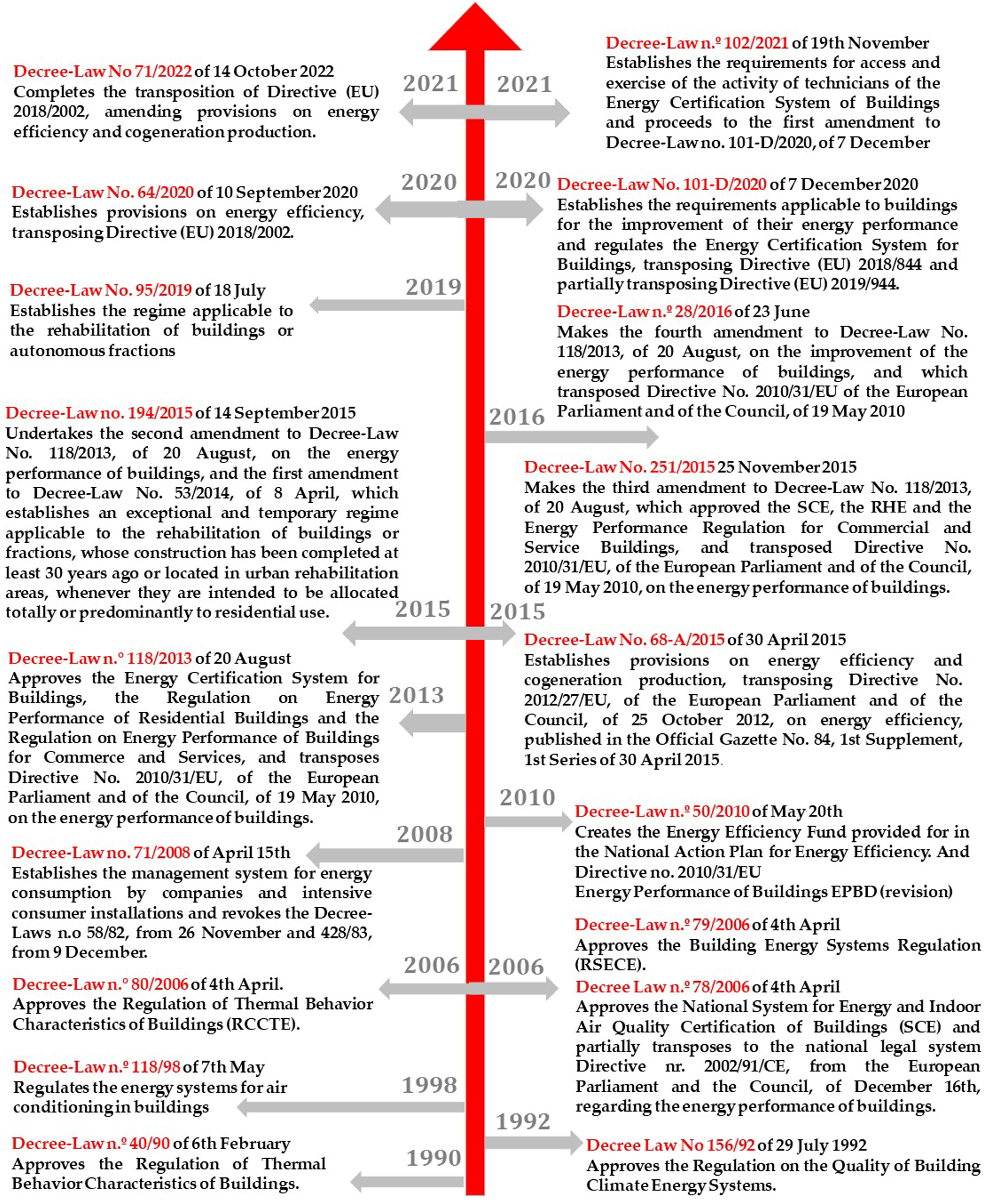
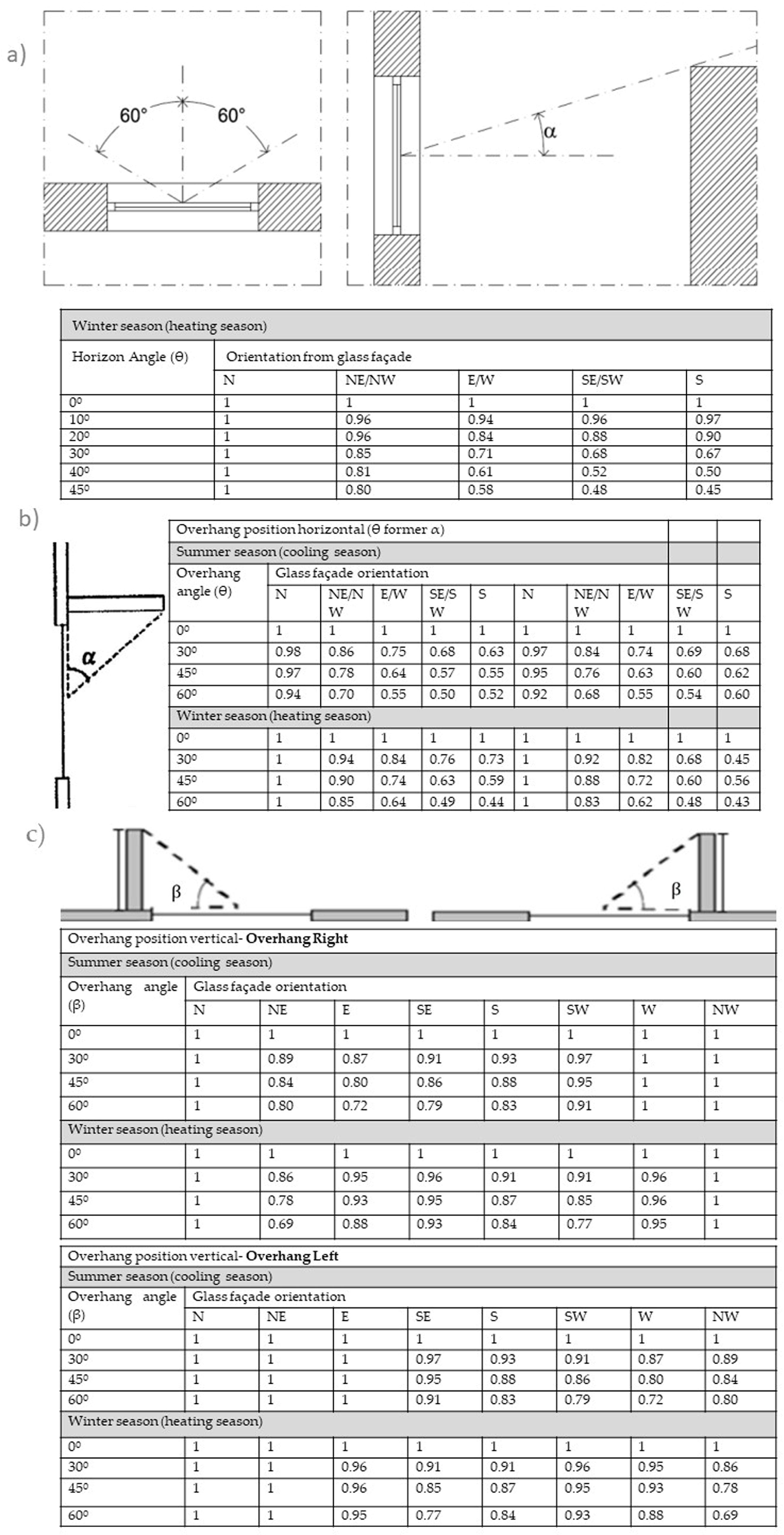
| Context | Year | Case Study | Objective Topics |
|---|---|---|---|
| Global | 1984 | Ryerson [10] | Compares if computed shadows and shadows measured from aerial photography are reliable and accurate during the mapping procedure. |
| 1996 | Belakehal [11] | Maximises the shading on the facade by optimising its components, using experimental aesthetic facade components to control solar radiation as the energy-related function and the aesthetical expression of its design. | |
| 1996 | Al-Sallal [12] | Investigates the geometrical relationships between the building form and the sun’s location and motion at critical times of the year. | |
| 2000 | Belakehal [13] | Classifies optimal variants of the facade that can provide recommendations for a shading strategy optimisation according to solar orientation. | |
| 2003 | Capeluto [14] | The model allows for the generation of the building shape in a way that the building facades are self-shaded during a required period determined by the designer. | |
| 2004 | Bourbia [15] | Study indicates that street canyon orientation (and not only the H/W ratio) has a considerable effect on solar shading and urban microclimate. Solar access to streets can always be decreased by increasing H/W to larger values. | |
| 2010 | Chua [16] | Demonstrated how the design of shading devices and the selection of glazing type impact the cooling load of high-rise residential buildings. Comparing results from the model simulations, the half egg-crate louver was found to be the most suitable shading device for residential buildings facing the north and south orientations. | |
| 2011 | Hayman [17] | Study about solar access and overshadowing of public and private open space in urban areas as the density and the height of buildings increase. All methods of analysis require a knowledge of the relative position of the sun. | |
| 2014 | Grynning [18] | Solar shading systems are vital to reduce the cooling demand of an office, and the simulations show that the choice of shading strategy can have an impact on the energy. | |
| 2015 | Shukla [19] | Studies solar access and overshadowing of public and private open space in urban areas as the density and the height of buildings increase. Detect limited periods of the day and small differences between the real and nominal location that could result in a proposed development application being denied. | |
| 2015 | Aksamija [20] | Controls the physical environmental factors that must be considered during the design process. | |
| 2016 | Simón-Martín et al. [21] | Presentation of various methods of measuring diffuse solar irradiance; shadowing devices are some of the most commonly used in solar research all over the world. | |
| 2017 | Lee et al. [22] | This study explores how the pattern and different characteristics are evaluated by varying facade shading types and considering their impact on daylighting metrics, with changes in the facade shading types, input parameters and azimuth orientations. | |
| 2020 | Sari [23] | During the early design stage, studies the process and the energy simulation, combining parametric software (Climate Consultant, Rhino/Grasshopper, Honeybee, Ladybug and DIVA) allowing more accuracy to allow a better energy analysis (solar, shade, etc.). | |
| 2020 | Kimm [24] | Study that describes in detail the algorithm which builds on precedents for 2.5D raster calculation of shadows. | |
| 2021 | Garreau [25] | Finds a compromise between the available data, the different modelling, thermal zoning models and solar shading models that analyse data using the same methodology, assessing the modelling parsimony. | |
| 2022 | Dagher [26] | Makes use of shadows to minimise solar transmission and heat gains in extreme weather. A study to reduce solar gains that can be an appropriate method to also improve thermal comfort without compromising the daylight factor. | |
| 2022 | Wen et al. [27] | Understands how buildings can be arranged to maximise the beneficial effect of shading in summer while minimising its adverse effect in winter would support the energy efficiency of urban buildings in different climate conditions (studies in China). | |
| 2022 | Wen et al. [28] | Studies how the different designs of surrounding buildings affect the window-transmitted solar radiation energy (WTSRE) of the target building by performing a parametric study using EnergyPlus and proposes a method that can rapidly assess the shading effect of surrounding buildings at the design stage based on the databases obtained from the parametric study. | |
| 2023 | Wang et al. [29] | Using the existing neighbourhood judgement criterion, shadow calculation methods evaluate its effectiveness in two case studies. Both calculations are accurate and effective and improved when the proposed criterion was integrated. | |
| European | 1998 | Trujillo [30] | Evaluates methods to calculate building performance under direct solar radiation and the energetic benefit when two different alternatives of solar protection are applied. |
| 2010 | Carneiro, C. et al. [31] | Studies urban environment quality (UEQ) using different techniques and proposes a correct definition of indicators (solar, shadow, etc.) related to urban developments. | |
| 2016 | Grifoni, R.C. et al. [32] | A case study that begins by estimating solar radiation and then evaluates useful parameters, such as the sky view factor and shadows. | |
| 2017 | Kite [33] | Chronological framework that reveals the key places and moments where shadows shape architecture in different and dynamic ways. | |
| 2017 | Valladares-Rendón et al. [34] | The aim of this research is to establish and recommend the most effective and balanced solutions to decrease insolation and increase energy savings while balancing daylighting and visibility. Four main classes were reviewed: facade self-shading, shading devices, window-to-wall ratio and building orientation. | |
| 2017 | Vartholomaios [35] | Studies strategies of high urban compactness and passive solar design and the synergy that can be achieved at different urban densities. | |
| 2020 | Alagoz and MBeyhan [36] | Lists advantages and disadvantages of different methods aimed to reach an optimum solution by considering the potential to create shadows on the building. | |
| 2021 | Kanters [37] | A study of urban planners working in Swedish municipalities that identifies a baseline, gaps and needs of solar-shadow-energy analysis. | |
| Portuguese | 2009 | Silva [38] | Study of the thermal behaviour of a building “case”, subject to different situations, including different orientations, different types of window shading and other components with impact. |
| 2012 | Silva and Henriques [39] | Studies a new methodology for calculating the shading factor, namely the shading factor for horizontal elements. | |
| 2016 | Lopes [40] | Lists comparative studies of the four calculation methodologies to have a better understanding of the methodological differences. | |
| 2016 | Ferreira [41] | Analyses the differences between the current regulations provided for houses (REH) and the previous regulations (RCCTE) to study what the main changes are in the calculation methodology and energy performance rating. | |
| 2016 | Costa [42] | Evaluates in what way the parameters related to the assessment of heat-energetic performance influence their own performance. | |
| 2017 | Carreira [43] | Explores procedures to estimate the shadow factor, comparing methods provided in the Portuguese regulation and evaluating their accuracy. | |
| 2019 | Brito, M. et al. [44] | Studies the difficulties in assessing solar potential in urban areas: contiguous or neighbouring buildings not included in the study area cast shadows on the studied buildings; thus, for a large study area, a mosaic of areas with a significant overlap is required to avoid overestimation of incident irradiation. |
| Method/Software | Calculation | Advantages | Disadvantages |
|---|---|---|---|
| Calculation Typology—CAD (computer-aided design) | |||
| SOMBRERO [52] | Geometric coefficient of shadow | Low cost User friendly | Does not calculate Fs, by default (quantifies shadow on object) |
| SHADING [53] | Geometric coefficient of shadow | Low cost User friendly | Does not calculate Fs, by default (quantifies shadow on object) |
| ShadowFX [54] | Geometric coefficient of shadow | Low cost User friendly | Does not calculate Fs, by default (quantifies shadow on object) |
| TownScope [55] | Radiation maps and shadow duration | Calculates several parameters in a single simulation | Implementation of auxiliary routines to obtain Fs |
| Sunhours [56] | Shading factor (complementary) | Easy building (Sketchup extension) | Does not calculate Fs, by definition (refers to shading loss) |
| Calculation Typology—MDE (digital elevation models) | |||
| GOSOL [57] | Shadow map Sun diagrams | Allows the importation of CAD models | Use an MDT Needs routine calculation for Fs Existence of auto-shaded spots |
| SOL [58] | Shadow map and global direct and diffuse radiation | Uses multidimensional scaling data (MDS) (obstructions already represented) | Lacks Fs calculation routine Existence of auto-shaded spots |
| Solar Analyst [59] | Sun diagrams, shadow map and global direct and diffuse radiation | Uses MDS An extension of ArcGis | Needs the algorithm for calculating Fs Non-existence of auto-shaded spots |
| On-site obstruction recording devices | |||
| SunEye 210 Shade Tool [60] | Sun diagrams | Portability Easy to use Adaptability | High cost Lacks algorithm for calculating Fs |
| Solar Pathfinder [61] | Sun path diagram | It can be used any time of the day or the year, in either cloudy or clear weather | Works on a reflective principle rather than actually showing shadows |
| HORIcatcher [62] | Sun diagrams | Easy and fast tool Supplied with a digital camera | Lacks algorithm for calculating Fs |
| The methodologies defined in Portuguese law | |||
| Calculation methodologies [63] | Shading factor | Calculation of Fs, as a function of the specific angles of obstruction and orientation | Requires auxiliary tool to calculate the obstruction angles Time-consuming process |
| Simplification rules [63] | Shading factor | Easy application Fast No auxiliary tools needed | May prove inaccurate by including only 3 shading classes Local analysis |
| Other combined methods | |||
| Envi-met [64] | Shadow casting Reflection analysis | Calculates several parameters in a single simulation | High cost |
| Ladybug [65] | Shadow map Sun path diagram Sun diagrams Global direct and diffuse radiation | Free Calculates several parameters in a single simulation A plugin for Rhino and Revit Interaction with CAD and BIM | Not a stand-alone Needs a definition to calculate |
| Shading Schemes with Identical α Angles and Distinct l’ Distances | Shadow Masks South Facing Facade θ = 30° | Shadow Masks South Facing Facade, θ = 45° | Shadow Masks South Facing Facade, θ = 60° |
|---|---|---|---|
 | 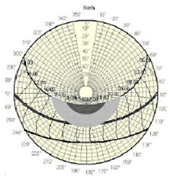 |  |  |
 |  | 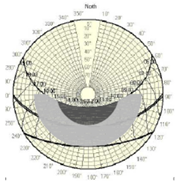 | 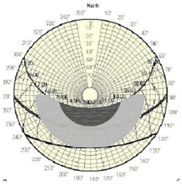 |
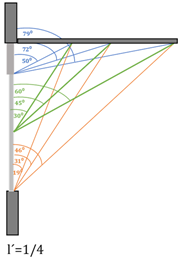 | 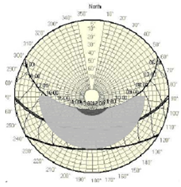 | 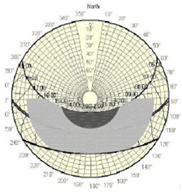 |  |
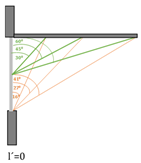 | 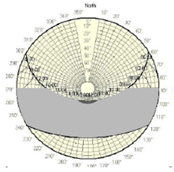 |  | 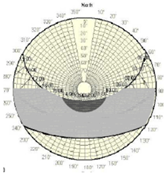 |
| Proposed angles by Silva and Henriques (2012) to be used in determining the shading factor | |||
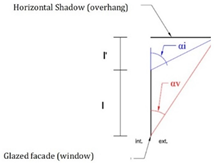 | |||
| Periods of the Year That Must be Taken into Account when Calculating Shading | ||||
|---|---|---|---|---|
 Figure Adopted from The National Weather Service (NWS) | ||||
| Hours | Autumnal Equinox | Winter Solstice | Vernal Equinox | Summer Solstice |
| 12 h–13 h | 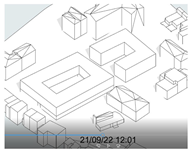 |  |  |  |
| 14 h–15 h | 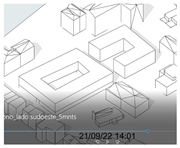 |  |  |  |
| 16 h–17 h |  |  | 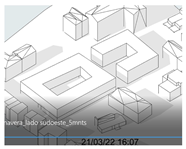 |  |
| 18 h–19 h |  |  |  |  |
| Sun hours of each day | ||||
 |  |  | 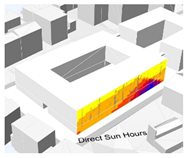 | 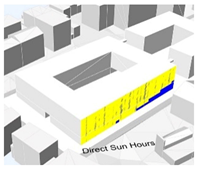 |
Disclaimer/Publisher’s Note: The statements, opinions and data contained in all publications are solely those of the individual author(s) and contributor(s) and not of MDPI and/or the editor(s). MDPI and/or the editor(s) disclaim responsibility for any injury to people or property resulting from any ideas, methods, instructions or products referred to in the content. |
© 2023 by the authors. Licensee MDPI, Basel, Switzerland. This article is an open access article distributed under the terms and conditions of the Creative Commons Attribution (CC BY) license (https://creativecommons.org/licenses/by/4.0/).
Share and Cite
Oliveira, M.F.; Mendonça, P.; Tenpierik, M.; Santiago, P.; Silva, J.F.; Silva, L.T. Shading Calculation Methods and Regulation Simplifications—The Portuguese Case. Buildings 2023, 13, 1521. https://doi.org/10.3390/buildings13061521
Oliveira MF, Mendonça P, Tenpierik M, Santiago P, Silva JF, Silva LT. Shading Calculation Methods and Regulation Simplifications—The Portuguese Case. Buildings. 2023; 13(6):1521. https://doi.org/10.3390/buildings13061521
Chicago/Turabian StyleOliveira, Marta Fernandes, Paulo Mendonça, Martin Tenpierik, Pedro Santiago, José F. Silva, and Lígia Torres Silva. 2023. "Shading Calculation Methods and Regulation Simplifications—The Portuguese Case" Buildings 13, no. 6: 1521. https://doi.org/10.3390/buildings13061521
APA StyleOliveira, M. F., Mendonça, P., Tenpierik, M., Santiago, P., Silva, J. F., & Silva, L. T. (2023). Shading Calculation Methods and Regulation Simplifications—The Portuguese Case. Buildings, 13(6), 1521. https://doi.org/10.3390/buildings13061521







